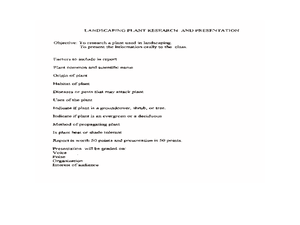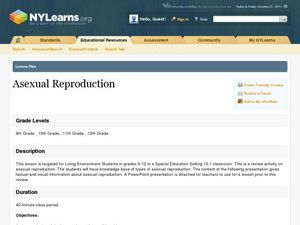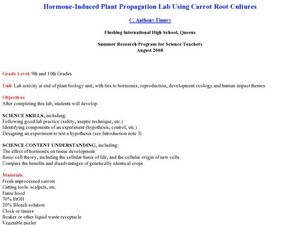Curated OER
Regents High School Examination: Living Environment 2005
The 2005 version of the Regents High School Examination in the area of ecology is as comprehensive as previous years' exams. It consists of 40 multiple choice questions on everything from the structure of DNA to the interactions within...
Curated OER
Plant Reproduction
Students investigate seeds and plant life by creating a germination chamber. In this botany lesson, students investigate the relationship between flowers and the fruit they produce while examining the structure of the flower. Students...
TED-Ed
The Sexual Deception of Orchids
A plant engaged in sexual deception? Strange but true. Believe it or not, orchids have developed a range of sexual adaptations that permit them to attract pollinators. The narrator of a short video describes a variety of strategies used...
Curated OER
Aliens Among Us
Students identify plants growing in the school yard and choose one for further investigation. They investigate the plant's biotic potential and environmental resistance. They predict what would happen should they introduce an exotic...
Alabama Wildlife Federation
Butterfly Gardening
Build a place for butterflies to call home. After identifying the needs of butterflies in terms of water, food, shelter, and reproduction, learners create a scale model of their ideal butterfly garden. Once the model is complete, they...
Curated OER
Flowers: Form and Function
Young scholars recognize and name the parts of a flower. They explain the function of each part of a flower. Students list the steps that occur for sexual reproduction of a plant to take place. They recognize and name the male...
Curated OER
Helping Plants Grow Well
Students investigate the effect of water, temperature, and light on plant growth. In this plant lesson, students identify the parts of the plant and participate in an online activity. The website is included in this lesson plan.
Curated OER
Eat Your Plants
Students explore fruits and vegetables. In this fruits and vegetables lesson, students work in small groups investigating plant parts. Students discover that fruits and vegetables originate from different parts of plants.
Curated OER
Plants, Plants, and More Plants
Students examine several types of plants. In this plant lesson, students complete activities that require them to identify types of plants, chart plant anatomy, and explain plant propagation.
Curated OER
Smarty Plants
Students examine plants and pollinators. In this plant biology lesson, students read The Power of Pollinators and identify the parts of the plant and the pollinators. Students design their own imaginary plants.
Curated OER
Living Things Experience Diverse Life Cycles
Second graders will study and explain the meaning of growth, development, and life cycle. They describe how plants grow and develop and observe an animal to show how it grows, changes, and reproduces throughout its life.
Curated OER
Asexual Reproduction
In this reproduction worksheet, students identify the 5 major ways organisms reproduce asexually and list examples of organisms that reproduce in that manor. Then students complete 10 short answer questions.
Curated OER
Asexual Reproduction
Sixth graders investigate how asexual reproduction produces single-parent offspring. They use plants and yeast to demonstrate vegetative propagation and budding in a laboratory. Students draw five different types of asexual reproduction.
Curated OER
PLANT PARTS WE EAT
Students identify an assortment of vegetables and learn how to locate the parts humans use for food. Students identify the plant parts we eat. Students color the pictures on their worksheets as provided. Students match the plants to the...
Curated OER
Plant And Animal Adaptations
Young scholars examine plant and animal life while looking at the environments the organismisms live in. They determine how form follows function by looking an aquatic turtle and noticing its feature of adaptation features. They work in...
Deep Look
The Sex Lives of Christmas Trees
Coniferous trees produce both male and female pine cones. The video explains the differences, how these trees reproduce, and why it is beneficial. It includes facts about the location, size, and age of pine trees.
Deep Look
This Vibrating Bumblebee Unlocks a Flower's Hidden Treasure
Some plants lock their pollen up until feeling the correct password. The video explains buzz pollination and how it differs from the pollination of other types of flowering plants. It lists multiple plants that require it and...
Curated OER
Plant Pollution
Learners study the different parts of a flower and their functions. For this pollination lesson students study a flower under a microscope.
Curated OER
Flowering Phenology: How Do Plants Know When To Flower?
Learners explore the biotic and abiotic factors that affect plant reproduction and the potential consequences of human activities on plant populations. The effects of urbanization are discussed as an influence in the consequences.
Curated OER
Flower Powder
Students collect and observe pollen. In this plant reproduction biology lesson, students use pollen boards to collect pollen from flowers, then match it with the correct paper flowers. Students move artificial bees from flower to flower...
Curated OER
Two Beets Or Not Two Beets—What Is Your Question?
Students use the scientific method to test an idea regarding the structures of a plant as it supports the biological evidence for life. In this growing roots instructional activity, students use organizing sheets to record their...
Curated OER
Pollinators and Wildflowers
Students explore how plants depend on pollinators to reproduce. In this pollination lesson students dissect a local flower and collect and identify pollinating insects.
Curated OER
Cell Structures and Their Functions
Life science learners investigate live cells. They examine wet mount slides of cyanobacteria and Elodea plants. They peer into the dynamic microscopic world of protists. Afterward, they construct a model of a cell, including rudimentary...
Curated OER
Hormone-Induced Plant Propagation Lab using Carrot Root Cultures
Students evaluate the importance of hormones in living things. In this biology lesson, students experiment on carrots to differentiate how humans and plants reproduce. They collect data from experiment to answer analysis questions.
Other popular searches
- Flowering Plant Reproduction
- Seedless Plant Reproduction
- Asexual Plant Reproduction
- Plant Reproduction Lab
- Plant Reproduction by Seeds
- Plant Reproduction Video
- Types of Plant Reproduction
- Plant Reproduction Parts
- Plant Reproduction Puzzles
- Plant Reproduction Do Now
- Sexual Plant Reproduction
- Plant Reproduction by Spores

























